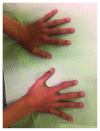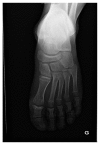Dysmorphic Short Stature: Radiological Diagnosis of Trichorhinophalangeal Syndrome
- PMID: 30584486
- PMCID: PMC6280227
- DOI: 10.1155/2018/5189062
Dysmorphic Short Stature: Radiological Diagnosis of Trichorhinophalangeal Syndrome
Abstract
Trichorhinophalangeal syndrome (TRPS), a type of skeletal dysplasia, is characterized by a triad of dysmorphic (bulbous nose and large ears); ectodermal (thin and sparse hair); and skeletal (short stature and cone-shaped epiphyses) findings, and this combination is helpful for early diagnosis and appropriate follow-up. A 14-year-old boy presented with short stature and distinctive facial features, and following the first clinical and biological evaluation, no precise diagnosis was reached. Progressive bilateral development of noninflammatory and painless deformity of his second finger required a radiological exam that highlighted the key elements (cone-shaped epiphyses) for final diagnosis. This case illustrates the difficulties to early recognition of TRPS when the clinical presentation is not complete and radiological findings are missing.
Figures





References
Publication types
LinkOut - more resources
Full Text Sources

